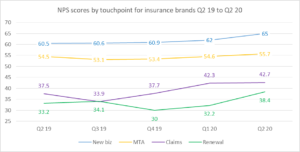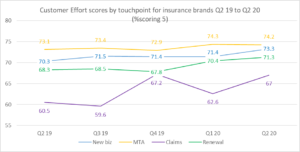How did the insurance sector’s service levels perform under lockdown?
25th August 2020

This article was first published by Insurance Business UK.
For the past decade ServiceTick, a Davies Technology, has been monitoring service levels for clients in the insurance sector; gathering transactional feedback from customers (i.e. feedback soon after the customer has had an interaction with the company). Our clients have used this data to inform and drive their operations and customer experience strategies and actions.
In March of this year, however, everything changed. Long established approaches to customer service were thrown out of the window when companies across the UK had to shift their workforce from office to home. According to a survey by Contact Doctors carried out in April 2020 some 84% of contact centres had moved to home working (up from 3.8% pre-lockdown).
Among our clients we witnessed herculean efforts to sustain service performance levels while moving staff to an effective home-working environment; and most were up and running within a couple of weeks. But for everyone moving from office to home significant change was required: new technology, new operations procedures, new workflows and new governance. Pressure on staff increased as colleagues went off sick, or were unavailable while new equipment was installed. On top of that a complete change of mindset was required for staff as they were coping with both tremendous changes in their personal life as well as their working practices.
What impact, if any did all this have on service performance?
After monitoring NPS and Customer effort via email surveys across a basket of more than 30 GI brands, we were able to benchmark how customers feel about their transactions with the insurance sector.
Source: ServiceTick GI client benchmarking
Since 2016 we have witnessed a steady improvement in the NPS scores across all our clients as a result of a stronger focus on customer experience. Clients have generated richer and deeper insights through Voice of the Customer programmes, like ServiceTick, and have used these to inform CX and operational strategies and effect change.
A similar picture can be seen in Customer Effort scores although the improvement in new business, MTA and renewal is not as marked.
Source: ServiceTick GI client benchmarking
Against this backdrop of improving CX metrics what impact did the coronavirus, lockdown and a seismic shift to home-working have on customer perception of service? In the charts below we have looked at the same data but over the shorter time period of Q2 19 to Q2 20.
Source: ServiceTick GI client benchmarking
Across our basket of GI brands we saw improvements in NPS at new business, MTA and renewal, while claims scores held steady. At all touchpoints NPS was higher in Q2 20 than it had been in Q2 19.
And a similar pattern was seen in Customer Effort
Source: ServiceTick GI client benchmarking
At first glance this may seem counterintuitive but there are a number of vital factors that led to improved customer metrics.
- Companies adapted swiftly to the new requirements for working from home. Most were up and running in a matter of weeks so any decline in metrics was quickly reversed. We did see isolated instances of drop-off in April but these were swiftly remedied by late-April/May.
- Some companies suspended new business activity while they implemented new procedures leading to reduced demand in the contact centre.
- Demand was also curtailed by the significant reduction in motor claims during Q2. With cars off the road many of our clients were reporting up to a 50% reduction in motor claims. This meant greater capacity for other touchpoints (although there was an increase in travel claims that companies had to contend with).
- But the key to the rise in metrics was that customer expectation was lowered. With most customers expecting no or slow response times they were pleasantly surprised to find service levels at near normal. One client’s customer commented: “Especially given the current circumstances of lockdown – the claim handlers dealt with our claim incredibly quickly and I am incredibly impressed”. And customers on the whole were far more forgiving “Getting through to you to renew was difficult, (41mins on one day and gave up) although I realise much of this was due to the current COVID situation, with staff off and/or working from home. The chap we eventually spoke to was excellent.”
- Customers were also better able to empathise with the situation that the insurance sector found itself in. COVID and lockdown was a shared experience across the whole community, business and social. Customers had their own work experience of dealing with COVID so were more understanding and tolerant. Above all this, it was not seen as a solely business issue that the insurance sector should necessarily have overcome. “I do understand that COVID-19 is a big issue for many businesses’ operations and you coped well”.
So, in summary, top marks for the insurance sector. They responded swiftly and effectively, supporting customers and staff alike. What remains to be seen is whether customers are as forgiving as the coronavirus crisis continues. We’ve started to see a downturn in metrics for many business partners which may indicate that sympathy and understanding from customers might be starting to wane. And we know that businesses are wrestling with the prospect of asking staff to return to their offices with all that this entails.
So, what does this mean for the future of CX? How will customer expectations change over the coming months and years? Time will tell…but we do know that the metrics collected through Voice of the Customer programs will help inform our business partners what matters most to their customers and help them to continue to shape their products and services around this.
Related Articles
-
- Article
- Legal Solutions
Retailers prepare for surge in COVID-19 claims
This article was first published in Insurance Business UK. Socially distanced…
-
- Article
- Claims Solutions
- Technology
Kuarterback - our latest investment in artificial intelligence
Kuarterback is our latest in a line of successful automated claims…
-
- Article
- Claims Solutions
A perfect storm for fraudulent claims
Fraud thrives during difficult economic times and claims handlers need to…
-
- Article
- Consulting
3 Strategies for Enhancing the Engagement of your Remote Workers
Whatever your personal preference – one of the legacies of lockdown…







